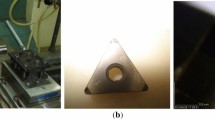Abstract
The present article studies the effect on cutter wear of balancing transverse cutting forces during inclined milling applied to a titanium alloy (Ti6Al4V). Indeed, this method is advantageous as it helps reduce vibrations as also the amplitude of such forces thanks to balancing. These observations provide the means to enhance cutting conditions and thus boost productivity when roughing. The method was first validated on Ti6Al4V titanium alloy. A model was then proposed to estimate the maximum axial cutting force at angular positions 0 and p. A wear test was then conducted and notching, flaking and flank types of wear were observed as being most representative. Roughness measurements were made throughout the wear test as also measurements of cutting forces with a new cutter and the worn cutter to provide a comparison. The cutting forces remained acceptable and the roughness values measured remained below the criteria generally retained for roughing. The improvements obtained in terms of extended tool life when using this method were extremely significant since under the same cutting conditions flat milling gave a lifetime of 2.03 min while when machining with balancing of the transverse cutting forces this was extended to 23.6 min.
Similar content being viewed by others
References
Schulz H (2004) Proceeding of the international conference on high speed machining, Nanjing, China, pp 1–20
Brinksmeier E, Walter A, Reucher G, Solter J (2008) Int J Mach Mach Mater 4(4):419. doi:10.1504/IJMMM.2008.023723
Rahman M, Wang ZG, Wong YS (2006) JSME Int J Ser C Mech Syst Mach Elem Manuf 49(1):11. doi:10.1299/jsmec.49.11
Rauch M, Hascoet JY (2012) Int J Adv Manuf Technol 59(1–4):47. doi:10.1007/s00170-011-3498-9
Danis I, Wojtowicz N, Monies F, Lagarrigue P (2014) International Journal of Mechatronics and Manufacturing Systems 7(2):141. doi:10.1504/IJMMS.2014.064750
Gilles P, Monies F, Rubio W (2007) Int J Mach Tools Manuf 47 (15):2263. doi:10.1016/j.ijmachtools.2007.06.003
Gilles P (2008) Positionnement d’outil torique pour l’usinage, de surfaces gauches en fraisage 5-axes avec équilibrage de l’effort de coupe transversale. Ph.D. thesis, Université de Toulouse, Université Toulouse III-Paul Sabatier
Gilles P, Cohen G, Monies F, Rubio W (2013) Int J Adv Manuf Technol 66(5–8):965. doi:10.1007/s00170-012-4381-z
Cheng K (2008) Machining dynamics: Fundamentals applications and practices. Springer
Ezugwu E (2005) Int J Mach Tools Manuf 45(12–13):1353. doi:10.1016/j.ijmachtools.2005.02.003
Konig W (1978) Proceedings of 47th meeting of AGARD structural and materials panel, Florence, Italy pp. 1.1–1.10
Sun J, Guo Y (2008) Int J Mach Tools Manuf 48(12–13):1486.
Ezugwu EO, Wang ZM (1997) J Mater Process Technol 68(3):262. doi:10.1016/S0924-0136(96)00030-1
Elmagrabi N, Hassan CC, Jaharah A, Shuaeib F (2008) Eur J Sci Res 22(2):153
Cohen G, Segonds S (2008) Int J Mach Mach Mater 4(4). doi:10.1504/IJMMM.2008.023722
Wagner V, Duc E (2014) Int J Adv Manuf Technol 75(9–12):1473. doi:10.1007/s00170-014-6217-5
Nouari M, Calamaz M, Girot F (2008) Comptes Rendus Mécanique 336(10):772. doi:10.1016/j.crme.2008.07.007
Nabhani F (2001) Robot Comput Integr Manuf 17(1–2):99. doi:10.1016/S0736-5845(00)00042-9
Su Y, He N, Li L, Li X (2006) Wear 261(7–8):760. doi:10.1016/j.wear.2006.01.013
Che-Haron CH (2001) J Mater Process Technol 118(1–3):231. doi:10.1016/S0924-0136(01)00926-8
Author information
Authors and Affiliations
Corresponding author
Rights and permissions
About this article
Cite this article
Moussaoui, K., Monies, F., Mousseigne, M. et al. Balancing the transverse cutting force during inclined milling and effect on tool wear: application to Ti6Al4V. Int J Adv Manuf Technol 82, 1859–1880 (2016). https://doi.org/10.1007/s00170-015-7518-z
Received:
Accepted:
Published:
Issue Date:
DOI: https://doi.org/10.1007/s00170-015-7518-z




